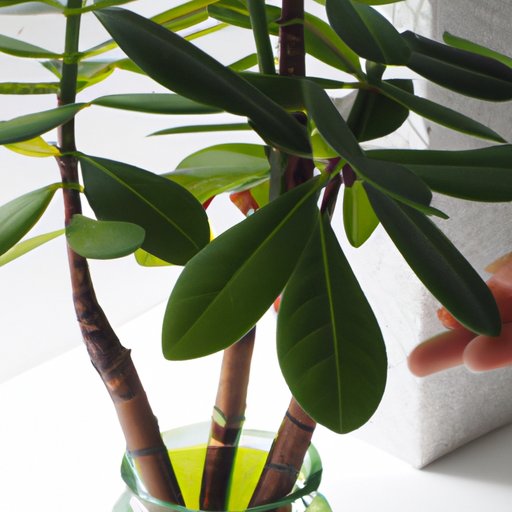Introduction
If you’re the proud owner of a money tree, you know just how beautiful and rewarding they can be. As a symbol of good luck and prosperity, money trees have become increasingly popular in homes and offices around the world. However, while they may be low-maintenance, it’s essential to know how to care for them correctly to keep them healthy and thriving.
Before we dive into the details of caring for your money tree, let’s first discuss its origins and importance in various cultures. The money tree, also known as the Pachira aquatica, is native to Central and South American swamps. In Asia, where it is believed to bring good luck and fortune, it is often seen in homes, businesses, and temples. In Feng Shui, it is a powerful symbol of wealth, prosperity, and good fortune. Now, let’s explore the essential factors that contribute to the health of your money tree.
Choosing the Right Pot
One of the most crucial decisions you’ll make when caring for your money tree is choosing the right pot. Choosing an appropriate pot size is critical because this will determine the amount of space your tree has to grow and develop its roots. Experts recommend choosing a pot that is at least two inches wider in diameter than the current pot your money tree is in.
When it comes to choosing the right type of pot, it’s best to opt for a breathable container that allows proper drainage. This will prevent overwatering and potential rotting of the roots. Terra cotta, plastic, and glazed ceramic are all great potting materials for a money tree.
Furthermore, selecting the right potting mix is equally important. Choose a soil that drains well, is rich in nutrients, and promotes good drainage. Adding perlite or sand to your potting soil can help improve drainage.
Watering
Watering your money tree correctly is perhaps the most important factor in keeping it healthy. These trees are naturally drought-tolerant, and overwatering is one of the most common mistakes owners make.
The recommended frequency of watering will depend on several factors, including pot size, temperature, and amount of light. In general, it’s best to water your money tree once a week, but it’s essential to monitor the soil’s moisture level. Never let the soil dry out completely, as this can lead to leaf loss and root damage.
When watering your money tree, use room temperature water, as water that is too cold or too hot can shock the roots. Water the plant until water starts to come out of the drainage holes in the bottom of the pot. Ensure that you allow the soil to dry out before watering again.
Light
Adequate lighting is crucial to the health and growth of your money tree. These trees thrive in bright but indirect sunlight. Direct sunlight can scorch the leaves and cause damage to the tree. However, not enough light can lead to stunted growth and leaf drop.
In general, it’s best to place your money tree near a window that receives ample daylight but not direct sunlight. If you notice your money tree leaning towards the light source, rotate the pot every few weeks to ensure uniform growth.
Fertilizing
While money trees are relatively low-maintenance, they do benefit from regular fertilization. Fertilizing helps promote healthy growth and the development of new foliage.
When it comes to choosing the type of fertilizer, there are a few options. You can opt for a slow-release fertilizer or liquid fertilizer, depending on your preference. Slow-release fertilizer is typically applied once every two to three months, while liquid fertilizer is used more frequently, roughly once a month.
When fertilizing your money tree, be careful not to over-fertilize, as this can lead to an excess of nutrients and potential damage to the roots.
Pruning
Pruning plays an essential role in keeping your money tree healthy. It helps manage its size, remove dead or damaged leaves and branches, and promote the growth of new foliage.
When pruning your money tree, it’s best to do so during the growing season, typically spring or summer. Start by trimming any dead, yellow, or brown leaves and branches. You can also prune back up to a third of the overall plant size to help keep it manageable.
When pruning, use sharp, sterile pruning shears to ensure a clean cut. Avoid using regular scissors or dull blades, as these can crush or damage the branches.
Common Problems
Despite their relatively low-maintenance needs, money trees can be affected by pests and diseases from time to time. These can include spider mites, mealybugs, and scale insects. If you notice any signs of infestation, such as yellowing or distorted leaves, gently wash the plant with a mixture of one part water and one part isopropyl alcohol.
Additionally, it’s essential to be mindful of overwatering, which can lead to root rot. Signs of root rot can include yellowing or browning leaves, wilting, and a smelly soil. If you suspect root rot, remove the plant from its pot, gently scrape away any affected roots, and repot in fresh soil.
Conclusion
Caring for your money tree is a rewarding and enjoyable experience when done correctly. Choosing the right pot, watering appropriately, providing adequate light, and fertilizing and pruning as needed can help ensure a healthy and thriving plant. By avoiding common mistakes and addressing any problems promptly, you can enjoy the beauty and good fortune of, in many cultures, a symbol of prosperity.
Remember to maintain proper care consistently to allow your money tree to reach its full potential.
